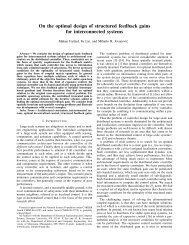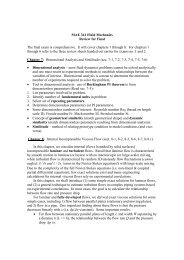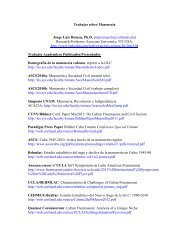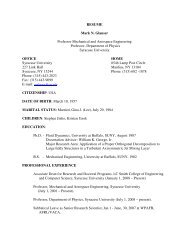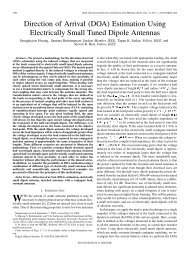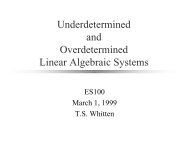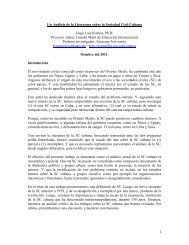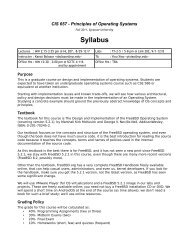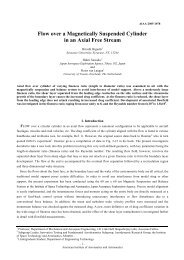Utilization of a Unitary Transform for Efficient Computation in the ...
Utilization of a Unitary Transform for Efficient Computation in the ...
Utilization of a Unitary Transform for Efficient Computation in the ...
Create successful ePaper yourself
Turn your PDF publications into a flip-book with our unique Google optimized e-Paper software.
180 IEEE TRANSACTIONS ON ANTENNAS AND PROPAGATION, VOL. 54, NO. 1, JANUARY 2006<br />
For higher values <strong>of</strong> <strong>the</strong> SNR, <strong>the</strong> bias <strong>of</strong> <strong>the</strong> estimator decreases,<br />
as expected.<br />
Fig. 2.<br />
RMSE <strong>of</strong> <strong>the</strong> DOA versus <strong>the</strong> number <strong>of</strong> antenna elements.<br />
VI. CONCLUSION<br />
In this paper, it has been shown that <strong>the</strong> computational complexity<br />
can be reduced <strong>for</strong> <strong>the</strong> MP method <strong>for</strong> DOA estimation.<br />
A unitary trans<strong>for</strong>mation applied to <strong>the</strong> MP method has been<br />
successfully <strong>for</strong>mulated and utilized to convert <strong>the</strong> complex data<br />
matrix to a real matrix, hence reduc<strong>in</strong>g <strong>the</strong> computational complexity<br />
significantly. It is seen that when <strong>the</strong> SNR <strong>of</strong> <strong>the</strong> data is<br />
greater than 10 dB, <strong>the</strong>n both <strong>the</strong> MP and <strong>the</strong> new UMP method<br />
can be used to model a given data set by a sum <strong>of</strong> complex exponentials<br />
and <strong>the</strong> UMP can be implemented on a DSP chip us<strong>in</strong>g<br />
only real arithmetic. The surpris<strong>in</strong>g part is that <strong>the</strong> real computations<br />
come at a cost, particularly <strong>for</strong> low values <strong>of</strong> SNR where<br />
<strong>the</strong> variance <strong>of</strong> <strong>the</strong> estimates due to <strong>the</strong> UMP method is larger<br />
than that <strong>for</strong> <strong>the</strong> MP method.<br />
ACKNOWLEDGMENT<br />
Grateful acknowledgment is made to <strong>the</strong> reviewers <strong>for</strong> suggest<strong>in</strong>g<br />
ways to improve <strong>the</strong> readability <strong>of</strong> <strong>the</strong> paper.<br />
Fig. 3.<br />
Bias <strong>of</strong> <strong>the</strong> estimator versus SNR.<br />
po<strong>in</strong>ted out <strong>in</strong> [9]. This causes some degradation <strong>for</strong> low SNR<br />
case. That expla<strong>in</strong>s <strong>the</strong> per<strong>for</strong>mance difference between <strong>the</strong> MP<br />
and <strong>the</strong> UMP methods <strong>for</strong> <strong>the</strong> low SNR case. After 8 dB SNR,<br />
<strong>the</strong> eigenvalues are all real. S<strong>in</strong>ce <strong>the</strong> results <strong>for</strong> are similar<br />
to we are giv<strong>in</strong>g <strong>the</strong> results <strong>for</strong> only . The optimum value<br />
<strong>for</strong> <strong>the</strong> pencil length, , is chosen to be 3 <strong>for</strong> efficient noise<br />
filter<strong>in</strong>g which is expla<strong>in</strong>ed <strong>in</strong> [7].<br />
The root mean square error (RMSE) <strong>of</strong> <strong>the</strong> DOA versus <strong>the</strong><br />
number <strong>of</strong> antenna elements <strong>for</strong> <strong>the</strong> UMP is shown <strong>in</strong> Fig. 2. As<br />
<strong>the</strong> number <strong>of</strong> antenna elements <strong>in</strong>crease, <strong>the</strong> RMSE decreases<br />
as expected. This simulation is based on <strong>the</strong> value <strong>of</strong> an SNR <strong>of</strong><br />
20 dB.<br />
The bias <strong>for</strong> <strong>the</strong> estimate <strong>of</strong> <strong>the</strong> DOA has also been studied.<br />
The bias is computed from<br />
(45)<br />
where denotes <strong>the</strong> expected value. The bias <strong>of</strong> <strong>the</strong> estimator<br />
versus SNR is shown <strong>in</strong> Fig. 3.<br />
REFERENCES<br />
[1] J. C. Liberti and T. S. Rappaport, Smart Antennas <strong>for</strong> Wireless Communications.<br />
Upper Saddle River, NJ: Prentice Hall, 1999.<br />
[2] J. Capon, “Maximum likelihood spectral estimation,” Nonl<strong>in</strong>ear<br />
Methods <strong>of</strong> Spectral Analysis, pp. 155–179, 1979.<br />
[3] R. O. Schmidt, “Multiple emitter location and signal parameter estimation,”<br />
IEEE Trans. Antennas Propag., vol. 34, no. 3, pp. 276–280, Mar.<br />
1986.<br />
[4] A. J. Barabell, “Improv<strong>in</strong>g <strong>the</strong> resolution per<strong>for</strong>mance <strong>of</strong> eigenstructurebased<br />
direction f<strong>in</strong>d<strong>in</strong>g algorithm,” <strong>in</strong> Proc. IEEE Int. Conf. Acoustics,<br />
Speech, and Signal Process<strong>in</strong>g, 1983, pp. 336–339.<br />
[5] K. Takao and N. Jijuma, “An adaptive array utiliz<strong>in</strong>g an adaptive spatial<br />
averag<strong>in</strong>g technique <strong>for</strong> multi-path environments,” IEEE Trans. Antennas<br />
Propag., vol. 35, no. 12, pp. 1389–1396, 1987.<br />
[6] Y. Hua and T. K. Sarkar, “Generalized pencil-<strong>of</strong>-function method <strong>for</strong><br />
extract<strong>in</strong>g poles <strong>of</strong> an EM system from its transient response,” IEEE<br />
Trans. Antennas Propag., vol. 37, no. 2, pp. 229–234, 1989.<br />
[7] T. K. Sarkar and O. Pereira, “Us<strong>in</strong>g <strong>the</strong> matrix pencil method to estimate<br />
<strong>the</strong> parameters <strong>of</strong> a sum <strong>of</strong> complex exponentials,” IEEE Antennas<br />
Propag. Mag., vol. 37, no. 1, pp. 48–54, 1994.<br />
[8] K. C. Huang and C. C. Yeh, “<strong>Unitary</strong> trans<strong>for</strong>mation method <strong>for</strong> angle<br />
<strong>of</strong> arrival estimation,” IEEE Trans. Signal Process<strong>in</strong>g, vol. 39, no. 4, pp.<br />
975–977, 1991.<br />
[9] M. Haardt and J. A. Nossek, “<strong>Unitary</strong> ESPRIT: how to obta<strong>in</strong> <strong>in</strong>creased<br />
estimation accuracy with a reduced computational burden,” IEEE Trans.<br />
Signal Process<strong>in</strong>g, vol. 43, no. 5, pp. 1232–1242, 1995.<br />
[10] A. Lee, “Centrohermitian and skew-centrohermitian matrices,” L<strong>in</strong>ear<br />
Algebra and Its Applications, vol. 29, pp. 205–210, 1980.<br />
[11] L. Datta and D. M. Salvatore, “Some results on matrix symmetries and<br />
a pattern recognition application,” IEEE Trans. Acoust., Speech, Signal<br />
Process<strong>in</strong>g, vol. ASSP-34, no. 4, pp. 992–993, Aug. 1986.<br />
[12] R. Bachl, “The <strong>for</strong>ward and backward averag<strong>in</strong>g technique applied to<br />
TLS-ESPRIT process<strong>in</strong>g,” IEEE Trans. Signal Process<strong>in</strong>g, vol. 43, no.<br />
11, pp. 2691–2699, Nov. 1995.<br />
[13] G. Xu, R. H. Roy, and T. Kailath, “Detection <strong>of</strong> number <strong>of</strong> sources<br />
via exploitation <strong>of</strong> centro-symmetric property,” IEEE Trans. Signal Process<strong>in</strong>g,<br />
vol. 42, no. 1, pp. 102–111, Jan. 1994.<br />
[14] H. V. Trees, Optimum Array Process<strong>in</strong>g, Part IV <strong>of</strong> Detection, Estimation,<br />
and Modulation Theory. New York: Wiley, 2002.<br />
[15] Y. Hua, “On Techniques <strong>for</strong> Estimat<strong>in</strong>g <strong>the</strong> Parameters <strong>of</strong> Exponentially<br />
Damped/Undamped S<strong>in</strong>usoids <strong>in</strong> Noise,” PhD dissertation, Syracuse<br />
Univ., Syracuse, New York, Aug. 1988.<br />
[16] L. C. Godara, Smart Antennas. Boca Raton, FL: CRC Press, 2004.




